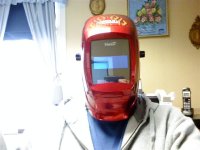Guys, I used to sell the AD Hoods. The damage from using a Cheepo hood will not be noticed for several years if ever. It is not something that you will know right away. Most Change from dark to light 3x faster than the speed of light so that part is safe. If your hood bothers your eyes it may be because you need a Cheater Lens to stop eye strain. Or go to a darker shade. The Delay feature is the opposite of what some said on here. The delay means that it stays dark for a couple seconds after you break the arc to let the puddle freeze so you dont have to see that white hot weld. Lastly,, The " Good " Hoods turn dark when the batteries fail or if all is not right to prevent a Flash. When you turn them on They go to shade 3 for the good ones and 4 or 5 for the cheepies. All the hoods out there are approved by our government specs so they all should be relativly safe.
I just registered after reading this post to point out the BS. Auto darkening helmets are nothing but large, single-segment LCD displays attached to a battery or solar panel (sometimes both, a solar cell can be used to complete a circuit so it can sort of function as a light sensor). Same sort of display on a pocket calculator but transparent and with just one segment that on, off, or somewhere in-between. LCDs are slow to switch on and off. Notoriously slow. They also have absolutely nothing to do with the speed of light. Look up "twisted-nematic" display. You will see there is physical molecular twisting going on to achieve the variations in transmitted light.
There are disadvantages to ALL auto-darkening helmets.
*There is a brief period where the AD glass has a current applied to but is still in the process of darkening. This period will be DRASTICALLY more noticeable at lower temperatures, at temperatures below freezing your glass might be stuck on or off until you warm it up again. This is because it is just an LCD. Leave a GPS or Game Boy outside in the cold and watch the screen have trouble transitioning between frames. The molecules are nearly frozen and they are slow to move.
*Solar cells do not respond to all wavelengths of light the same. Whereas ordinary darkened glass blocks out light nearly indiscriminately all the time, the LCD-based auto-darkening glass is dependent on a solar cell (or less often a CdS resistive sensor) to determine when to supply it the current it needs to darken. If you get flashed by a wavelength of light the sensor or solar cell is less sensitive to, it could very well go right through the glass and enter your eyes at nearly full intensity. Arc light is pretty much bright full-spectrum so the solar cell WILL see it but wavelength sensitivity is just another important thing to be aware of.
*An arc intensifying fast enough will probably flash your eyes a bit before the glass darkens. There is an advantage here for the AD option because the LCD is racing the intensifying arc, and the arc does not reach full intensity all at once. If it did, there would be even more arc exposure with these helmets, and more people would start to take notice.
You can test your helmet. Use a camera with a long exposure setting, place it right up against the internal glass, use something to cover the back of the helmet so light cannot get in from there, and open the shutter. Start an arc in front of the glass at a distance you are used to working from (do this a few times for good measure), you can also use a camera flash but then you would need two cameras (using a mirror may not work because you don't know precisely when the shutter will open, it needs to open before the flash begins illuminating). Close the shutter to finish the shot and see what develops. Too much light and you should know it, you can compare it to a ordinary darkened pane at the same shade.
There are safe alternatives to AD helmets, the chin-operated type is probably the most exotic:
YouTube - Welding Helmet Comparison Chin operated VS Light Activated That one's a little primitive and needlessly expensive for my liking, an AD lens (as a backup) under the main lens would be more ideal so that if you open your mouth to talk you don't get accidental arc-eye.
--I might add that the "my eyes are worth more than $XX" argument is silly although almost understandable. Anyone would pay more for a more expensive helmet if they knew it would protect their eyes better. Do really know what you're buying? Test your helmet. A high-speed video camera would really end the argument. Try using your helmet in the cold and recheck, there should inevitably be more delay. Even if AD helmets are not unsafe they are at best only CONDITIONALLY SAFE.

